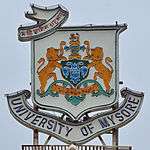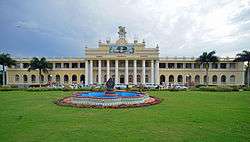University of Mysore
|
Crawford Hall, University of Mysore | |
| Motto | न हि ज्ञानेन सदृशम् |
|---|---|
Motto in English | Nothing is Equal to Knowledge |
| Type | Public |
| Established | 1916 |
| Chancellor | Vajubhai Rudabhai Vala |
| Vice-Chancellor | K.S. Rangappa |
| Students | 10,946 |
| Undergraduates | 5,250 |
| Postgraduates | 3,623 |
| Location |
Mysore, Karnataka, India 12°18′29.45″N 76°38′18.83″E / 12.3081806°N 76.6385639°ECoordinates: 12°18′29.45″N 76°38′18.83″E / 12.3081806°N 76.6385639°E |
| Campus | Urban |
| Affiliations | UGC, NAAC, AIU |
| Website | www.uni-mysore.ac.in |
 | |
The University of Mysore is a public state university in Mysore, Karnataka, India. The university was founded during the reign of Krishnaraja Wodeyar IV, the Maharaja of Mysore. It opened on 27 July 1916. Its first chancellor was the Maharaja of Mysore; the first Vice-Chancellor was H. V. Nanjundaiah. The university became the first outside of the British administration in India, the sixth in India as a whole, and the first in Karnataka. It is a state university of the affiliating type, and became autonomous on 3 March 1956, when it gained recognition from the University Grants Commission.[1]
The university encompasses 122 affiliated colleges and five constituent colleges (forming an aggregate of 53,000 students). In addition, the university has 37 postgraduate departments, eight specialised research and training centres, and two postgraduate centres that together offer a total of about 55 regular academic programs to 3,500 students. It also runs a number of employment-oriented diploma courses and certificate programs.
The Mysore University Library comprises over 800,000 books, 2,400 journal titles, and 100,000 volumes of journals. The main campus features an amphitheater, an auditorium, a swimming pool, and hostel accommodations for men and women. As of July 2013, the University of Mysore was accredited "Grade A" by National Assessment and Accreditation Council (NAAC),[2] while its academic staff was ranked amongst the top 5 across India.[3]
History
| Vice-Chancellors |
|---|
|
The University of Mysore is the 6th oldest university in India and the oldest in the state of Karnataka. It was established in 1916 by then Maharaja of Mysore, Krishnaraja Wodeyar IV, after two of his educational experts (C. R. Reddy and Thomas Denham) undertook a five-year study of higher education around the world. They structured the new school to encompass elements from universities that promote original research (University of Chicago), those that emphasise extending knowledge among the people (University of Wisconsin), and those that combine intellectualism with an educational system calculated to train students for political and social life (University of Oxford and Cambridge). H. V. Nanjundaiah, who played a key role in establishing the university, was elected by the Maharaja of Mysore to run the University as the first Vice-Chancellor, and he held the post until his death in 1920. Sir Mokshagundam Visvesvarayya, then Dewan of Mysore, also played a major role in its promotion. The university was inaugurated on 27 July 1916. Maharaja College of Mysore and the Central College of Bangalore, both previously affiliated with Madras University, became part of the new university. The Act was amended in 1933 and 1939 to make the senate representative of public life and to establish the academic council responsible for the academic affairs of the university.
During the reorganisation of Mysore state in 1956, the Mysore University Act passed, which made the university an autonomous body (this has since been superseded by the Karnataka State Universities Act, 2000). In 1960, the university's graduate centre was set up in the picturesque environs of Kukkarahalli lake. The national poet and Jnanpith Award winner, K. V. Puttappa (Kuvempu), a former Vice-Chancellor of the University, christened this campus 'Manasagangotri', meaning: 'the fountainhead of the Ganges of the Mind' or 'the eternal spring of the mind'. Bangalore University was carved out in 1964 starting with Central College, Bangalore, and the University Visvesvaraya College of Engineering. Mangalore University was formed out of the colleges in Dakshina Kannada in 1980.
Building
The main campus of the University, created in 1960, lies to the west of the Kukkarahalli Lake. The University headquarters, Crawford Hall, is located across the lake to the east. Two satellite campuses have since been set up in response to the demands for postgraduate education in suburban and rural areas: the Sir M.Visveswaraya Postgraduate Centre at Tubinakere in Mandya, and the Mysore University Postgraduate Centre at Hemagangotri in Hassan.
At the time of the University's founding, colleges in the entire state of Mysore came under its jurisdiction. This has since been limited to the Mysore, Mandya, Hassan, and Chamarajanagar districts, with the remaining areas falling under the remit of Bangalore University (1986), Mangalore University (1980), and Kuvempu University (1987). In 1996, the Institute for Correspondence Courses and Continuing Education in the Manasagangotri campus was separated from the University of Mysore to form the Karnataka State Open University.

Motto
The university's motto, "Na Hi Gyanena Sadrusham" (Nothing compares with knowledge) is taken from the Bhagavad Gita.[4] It is inscribed in Devanagari script at the top of the university crest. At the bottom of the same crest is a saying in Sanskrit, reading "Sathyamevoddharamyaham" (I uphold only the truth).
Recent academic restructuring
The university has recently changed academic direction, with a greater emphasis on basic science. It has introduced integrated MSc courses in physics, chemistry, and biochemistry. The University has also formed ties with various Chinese universities for resource sharing and training in information technology education.
The International School of Information Management, was created in 2005 through the collaboration of three US universities, as well as Dalhousie University of Canada, and IIIT, Bangalore.[5] Faculty members from these partnering institutions teach at ISiM.
The Third Sector Research Resource Centre (TSRRS) was established in 2004. The aim of the centre is '...to undertake and promote interdesciplinary [sic] studies and research in the domain of civil society,'[6] with a secondary aim of developing and offering Diploma and Masters programs in the management of non-profit organisations.[7]
More recently, the Department of Law in the university was incorporated into the Mysore University School of Justice (MUSJ). Continuing with the university's initiative to introduce five-year integrated courses to produce professionals with in-depth knowledge, the MUSJ has introduced a program leading to a degree in law,[8] as a bid to enhance the quality of legal education in Karnataka.
Other initiatives currently underway by the University are the establishment of a National Centre for History of Science, a digital library, a Centre for International Programmes, a school of life sciences, an IT division, and a joint campus with IIS-Bangalore. In the last five years, an Archaeological and Folklore Museum has been established in the Jayalakshmi Vilas Mansion with a donation from the Infosys Foundation.
University Evening College
University Evening College is one of the four constituent colleges of the university, (established in 1965 at the campus of Maharaja College) and is open to those who cannot pursue their studies on a regular basis. In accordance with the motto of the University "Nahi Jnaanena Sadrisham", this college has been catering to the educational needs of young as well as middle-aged adults.
The college's branch of the NSS (National Service Scheme) was awarded the national NSS award and NSS state award. Through the NSS unit, the college has '...created a space for the students to participate, enlighten and create a consciousness among the public about social, economic, cultural, legal and environmental issues of society.'
The college has an N.C.C (National Cadet Corps) unit. The N.C.C is a Tri-Services Organization, comprising the Army, Navy and Air Force.
Notable faculty
Notable alumni
- Jayachamarajendra Wodeyar
- AAMS Arefin Siddique
- E. S. Venkataramiah
- Srikanta Wadiyar
- Kuvempu
- K. Hanumanthaiah
- Poornachandra Tejaswi
- Alex Kaliyanil
- S. M. Krishna
- Sri Sri Shivakumara Swamiji
- S. Srikanta Sastri
- H. Narayan Murthy
- R. K. Laxman
- Ram Madhav
- Mysore Manjunath
- N S Narendra
- N. R. Narayana Murthy
- C. N. R. Rao
- S. K. Venkataranga
- A. K. Ramanujan
- Akhilesh Yadav
- Sadhguru Jaggi Vasudev
- Raghu Dixit
- Kalappa Muniyappa
- Kalya Jagannath Rao
- Tavarekere Kalliah Chandrashekar
See also
References
- ↑ Kumar, compiled by Ameeta Gupta; Ashish (2006). Handbook of universities : includes universities, deemed universities, colleges, private universities and prominent educational and research institutions. New Delhi: Atlantic Publishers & Distributors. p. 587. ISBN 9788126906086.
- ↑ "Institutions accredited by NAAC whose accreditation period of five years is valid" (PDF). NAAC. 8 July 2013. Retrieved 12 July 2013.
- ↑ "Review of Academic Staff Colleges" (PDF). National Assessment and Accreditation Council. Retrieved 12 July 2013.
- ↑ "Bhagavad Gita 4.38". Bhagavad Gita: With commentaries of Ramanuja, Madhva, Shankara and others. 13 December 2012. Retrieved 4 February 2015.
- ↑ "International School of Information Management – Partners". International School of Information Management – University of Mysore. Retrieved 4 February 2015.
- ↑ "India TSRRC" (PDF). Retrieved 4 February 2015.
- ↑ Narasimharao, B. PanduRanga (2013). Evolving Corporate Education Strategies for Developing Countries: The Role of Universities. IGI Global. ISBN 978-1-4666-2845-8.
- ↑ "Courses Offered – University of Mysore". University of Mysore. Retrieved 4 February 2015.
External links
| Wikimedia Commons has media related to University of Mysore. |
